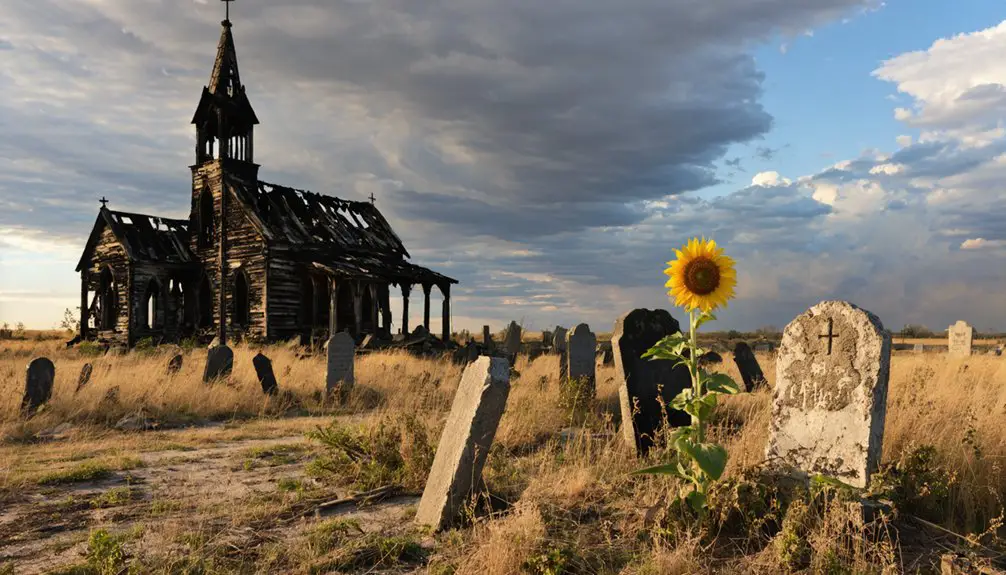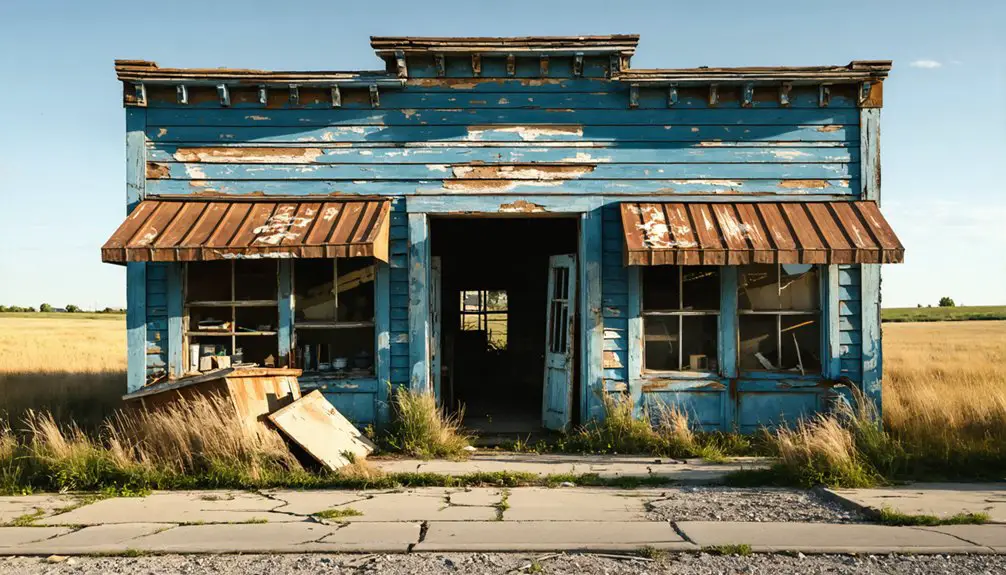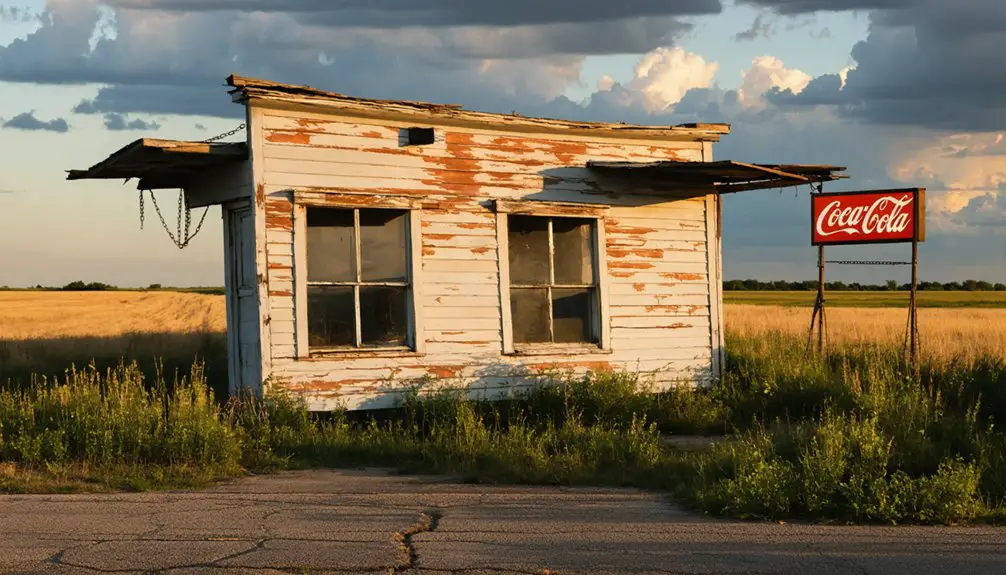You’ll find the ghost town of Englewood in Clark County, Kansas, where a once-thriving frontier settlement peaked at 5,000 residents in 1887. Founded as a strategic stop along the Texas Trail, the town boasted hotels, saloons, and an opera hall until a devastating 1908 fire destroyed its business district. Today, with only 58 residents remaining, Englewood’s abandoned buildings and empty streets tell a dramatic tale of the American West’s boom-and-bust legacy.
Key Takeaways
- Once a thriving cattle town founded in 1884, Englewood declined dramatically after a devastating fire in 1908 destroyed its business district.
- Population plummeted from 518 residents in 1910 to just 58 in 2020, transforming the town into a modern ghost town.
- Abandoned buildings and structures remain as historical remnants, attracting urban explorers and history enthusiasts.
- The town’s demise stemmed from multiple factors: the 1908 fire, the 1893 economic panic, and agricultural challenges.
- Visitors can explore the ghost town’s remains but should exercise caution due to structural hazards and obtain proper safety equipment.
The Birth of a Frontier Town
While the American frontier continued its westward expansion in 1884, the town of Englewood emerged as a strategic stop along the Texas Trail to Dodge City. Named after Chicago’s Englewood neighborhood, the town company marketed this Kansas settlement as the “Veritable New Chicago of the Great Southwest.”
You’ll find that amid frontier challenges, they laid out an organized community with public streets and alleys, reflecting their ambitious vision. Like other place name disambiguations, this Englewood had its own unique identity and characteristics.
The town quickly became a crucial hub for cattle drives and local agriculture, drawing settlers to its fertile rolling grasslands north of the Cimarron River.
By 1886, you could’ve found a bustling community with multiple businesses, including three drug stores, four dry goods stores, two hotels, and lumber yards.
Their 1885 post office establishment marked Englewood’s growing importance as a commercial center.
The town reached its peak prosperity with approximately five thousand residents in 1887, showcasing its rapid frontier growth.
Tales of Lawlessness and Vigilante Justice
Beneath Englewood’s veneer of organized development lay a darker reality of frontier justice and lawlessness. You’d find the town’s proximity to the Kansas-Oklahoma border made it a magnet for outlaws seeking refuge in “no man’s land,” where formal law enforcement struggled to maintain order. At its peak, the bustling city reached a population of 2,000.
Along the Kansas-Oklahoma border, outlaws found sanctuary in Englewood’s lawless frontier, far from the reach of justice.
When traditional justice failed, vigilante groups took matters into their own hands. You might’ve witnessed accused criminals hanging in the streets, followed by hasty burials – a stark reminder of frontier justice at work. Like the nearby Border Queen Caldwell, Englewood struggled with maintaining law and order.
The region’s saloons and gambling dens fueled frequent gunfights, with law enforcement officers often paying the ultimate price. In nearby Caldwell alone, 18 city marshals lost their lives between 1879 and 1885.
This persistent violence, coupled with other hardships, eventually drove residents away, leaving Englewood’s population dwindling by 1897.
Economic Rise and Agricultural Struggles
You’ll find Englewood’s early commercial promise reflected in its ambitious nickname “New Chicago of the Great Southwest,” with its 1884 founding sparking rapid growth that included multiple drug stores, hotels, and lumber yards by 1886.
The town’s agricultural foundation crumbled during the Panic of 1893, leading to widespread farm foreclosures and business closures that persisted despite a rancher’s land donation in 1906 to stimulate growth.
A devastating fire in 1908 destroyed the business district, accelerating Englewood’s decline and eventual transformation into a semi-ghost town with only 58 residents by 2020. The town’s remaining population is predominantly aging residents over 60, reflecting its status as a fading rural community.
Today, visitors can easily reach this historic site along U.S. 283, just three miles north of the Kansas state line.
Early Commerce Boom
As frontier settlement swept across Kansas in the 1880s, Englewood emerged as a promising commercial center when the Englewood Town Company formed in November 1884.
You’d have witnessed rapid frontier entrepreneurship as the town established essential services, including a post office by February 1885. By early 1886, cattle commerce thrived alongside two hotels, four dry goods stores, and three drug stores. The business district expanded to include two lumber yards, a restaurant, and the town’s first newspaper. Similar to Englewood’s later Kansas City namesake, the town brought entertainment to locals through motion picture shows.
The commercial peak hit in 1887 when Clark County boasted 5,000 residents. You’d have found entertainment at the combination skating rink and opera hall, while the strongest drink available was cider due to prohibition laws. A concrete block factory helped diversify the town’s industrial base.
Despite the modest population of 175 by 1890, Englewood’s early commercial excitement exemplified the spirit of western expansion.
Agricultural Crisis Unfolds
The agricultural prosperity that initially drew settlers to Englewood began unraveling in the late 1880s when volatile crop prices and mounting debt crushed local farmers.
You’d have witnessed crop fluctuations wreaking havoc on farm profits while falling price levels made debt repayment increasingly burdensome. The real net income of local farms plummeted sharply during this period, mirroring national trends. As world grain markets expanded, competition intensified, driving prices even lower.
The region’s semi-arid climate dealt another blow, as recurring droughts devastated harvests and pushed farmers onto marginal lands. The widespread hardships mirrored those of other farmers across the Northern prairie states.
Despite farmers’ calls for debt relief through interest rate limits and foreclosure mediation boards, many couldn’t survive financially. Banks foreclosed on properties, leaving unsettled land titles in their wake.
Failed Recovery Attempts
While farmers struggled with mounting debt and foreclosures, Englewood’s initial economic importance had shown promise before its decline. You’d have witnessed a thriving community of 5,000 residents in 1887, complete with hotels, stores, and even an opera hall – all evidence of the town’s early significance.
But failed recovery attempts plagued Englewood after the Panic of 1893. When a devastating fire destroyed much of the business district in 1908, you’d have seen the town’s hopes literally go up in flames.
Even a local rancher’s land donation in 1906 couldn’t reverse the economic challenges. The agricultural crisis, combined with the loss of essential infrastructure, created a downward spiral.
The Great Fire and Its Aftermath

If you’ve ever wondered about Englewood’s decline, the devastating 1908 fire marks a significant turning point when most of the town’s businesses burned to cinders.
You’ll find that this catastrophic event destroyed the town’s economic foundation, displacing residents and erasing essential commercial activity in the fledgling community.
Despite attempts to rebuild, the combined impact of the fire damage, environmental challenges, and population exodus proved too severe for the town to fully recover.
Devastating 1908 Business Losses
During one catastrophic night in 1908, fierce flames engulfed Englewood’s bustling business district, reducing drug stores, grocery stores, hotels, and lumber yards to smoldering ruins.
The business devastation proved insurmountable for most local entrepreneurs, who couldn’t recover their investments or secure adequate insurance coverage to rebuild.
The fire consequences rippled through the community with devastating effects:
- Complete destruction of the commercial center eliminated essential services and jobs
- Business owners lost their entire livelihoods with insufficient means to start over
- Economic activity in the town ground to a halt as shops remained in ruins
- The commercial losses triggered an exodus of residents seeking opportunities elsewhere
This economic catastrophe marked the beginning of Englewood’s decline into a ghost town, with its population eventually dwindling to around 100 residents by the late 20th century.
Rebuilding Efforts Fall Short
Despite local ranchers’ generous land donations and determined efforts to rebuild north of the original town site, Englewood’s post-1908 recovery proved inadequate to restore its former liveliness.
You’ll find that rebuilding challenges mounted quickly – damaged infrastructure, weakened structures, and extensive smoke damage made reconstruction costs soar beyond many residents’ means.
While the community’s resilience showed in their initial reconstruction attempts, they couldn’t overcome the compounded effects of unstable banks, confused land titles, and widespread bankruptcies.
Essential services remained compromised as electric poles stood damaged and supply chains broken. The limited financial resources and broader economic decline of the region ultimately sealed Englewood’s fate.
What began as a temporary setback became permanent, transforming a once-promising town into a shadow of its former self.
Population Changes Through Time
Established in 1884 as a cattle drive stop, Englewood’s population journey tells a story of dramatic rises and falls over nearly 140 years.
Founded as a frontier waypoint, Englewood’s 140-year saga captures the dramatic ebb and flow of small-town Kansas life.
The town’s demographic shifts reveal both remarkable growth and stark decline, testing the population resilience of this Kansas community.
Key population milestones include:
- Growth from 175 residents in 1890 to a peak of 518 by 1910, driven by railroad expansion
- Steady decline through the Great Depression, dropping to 377 by 1940
- Major population loss between 1950-1970, plummeting from 341 to just 158 residents
- Continued decline into the 21st century, with only 58 residents remaining by 2020
You’ll find this once-thriving cattle town has lost nearly 90% of its peak population, reflecting broader challenges faced by rural Kansas communities.
Modern Day Ghost Town Exploration

While Englewood’s abandoned buildings stand as silent witnesses to its past, modern ghost town exploration requires careful preparation and respect for both safety and preservation.
If you’re planning to explore this Kansas ghost town, you’ll need proper equipment including a GPS device, reliable lighting, and communication tools. Urban exploration here demands awareness of structural hazards and possible environmental risks.
You’ll want to follow ethical considerations that protect both you and the site’s historical integrity. Don’t remove artifacts or damage structures – instead, document your findings through photography and notes.
Consider joining guided tours when available, as local experts can provide valuable historical context while ensuring your safety. Many explorers share their experiences through online communities, contributing to the broader understanding of Englewood’s significance.
Frequently Asked Questions
Are Any Original Buildings From the 1880S Still Standing in Englewood Today?
You won’t find any original 1880s buildings with architectural significance standing today, as fires destroyed the historic preservation potential of these structures, leaving only foundations and later construction remnants.
What Happened to the Native American Populations in the Englewood Area?
You’ll find that Native Americans like the Kanza and Osage faced systematic displacement through federal policies and treaties, forcing them to Oklahoma’s Indian Territory by the 1870s, devastating their cultural traditions and communities.
Did Any Famous Outlaws or Historical Figures Pass Through Englewood?
Like a tumbleweed chasing whispers, you won’t find concrete proof of famous outlaws here. While historical travelers surely passed through on the Texas Trail, no documented outlaw legends are confirmed.
Are There Any Documented Ghost Stories or Paranormal Activities in Englewood?
While you’ll find a haunting backdrop of old buildings and violent history, there aren’t any verified ghost sightings or documented paranormal investigations in the area, despite its ghost town appearance.
Can Visitors Legally Explore Abandoned Buildings in Present-Day Englewood?
You can’t legally explore abandoned buildings without explicit permission from property owners. Despite limited oversight, trespassing laws still apply, and you’ll need written consent for any abandoned exploration.
References
- https://www.youtube.com/watch?v=HpolfSLrhsE
- https://www.ghosttowns.com/states/ks/englewood.html
- http://freepages.rootsweb.com/~gtusa/history/usa/ks/englewood.htm
- https://www.youtube.com/watch?v=C6yRUWAhTv0
- https://en.wikipedia.org/wiki/Englewood
- https://freepages.rootsweb.com/~gtusa/history/usa/ks.htm
- https://www.youtube.com/watch?v=OyBXD18P_j4
- https://legendsofkansas.com/kansas-ghost-town-list/
- https://fhsuguides.fhsu.edu/kansasheritage/clarkcounty
- https://www.jchs.org/jchs-e-journal/caugerfamilysfilmservice



